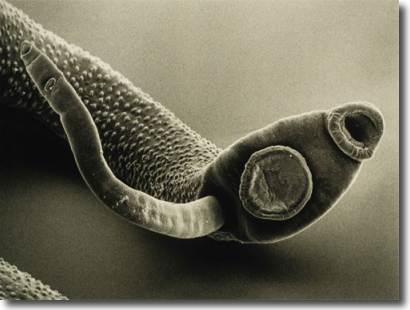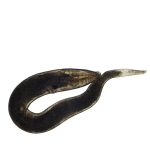

An extraordinary variety of viruses, bacteria, parasites, and organisms stand ready to attack us and feed
off our bodies' cells. Using microscopes of varying power, photographers
show us a teeming microbial world that we could barely imagine without their help.
The approximate sizes of microbes can be approximated by using the following rule of thumb:
- VIRUSES are the smallest of all infectious agents, averaging about 100 nanometers
(100 billionths of a meter) in length. They have so few genes and proteins of their own that in order
to reproduce they need to commandeer the machinery of the cells they invade.
- BACTERIA vary widely in size and shape, but tend to be at least 10 times larger
than viruses, or at least 1 micrometer (1 millionth of a meter) long. They are single-cell
organisms that reproduce independently.
- SINGLE-CELL ORGANISMS tend to be at least 10 times larger than bacteria, or
about .01 millimeter long.
- MULTI CELLULAR ORGANISMS are so large they can usually be seen with the naked eye.
Tapeworms, for instance, can reach a length of 6 meters (20 feet).

Food and water are the
most common sources of parasite and invading organism transmission.
Since most of us eat three times a day and drink water frequently
throughout the day,
our exposure to these sources is constant. Tap water has been found to
be contaminated with harmful organisms. Both plant and animal foods
carry parasites,
and cleaning and cooking methods often do not often destroy them before
ingestion. The CDC (Center for Disease Control) cites food as the
catalyst behind 80 percent
of the pathogenic outbreaks in the U.S. Most are linked to restaurants
and delis where less than sanitary conditions exist -- from food
preparation and storage
to the utensils and servers' hands.
 Animals,
just like humans, can become infected with parasites and unhealthy
organisms.
Internally, contaminated water and food can spread the problem to our
pets. Externally,
animals become infected by organisms on their bodies, especially on
their fur, because of exposure to infected animal wastes. Forgetting to
wash your hands
even one time after handling or cleaning up after your animal can
transmit the parasite to you. Pets are a wonderful part of our lives.
They provide comfort,
companionship, protection, amusement, and unconditional love for their
owners. Yet, pets, like humans, are often victims of serious infections
that can
unintentionally be passed on to their owners. In fact, there is a whole
set of diseases classified as 'zoonoses' (animal-transmitted diseases)
in parasitology textbooks.
Animals are major carriers of harmful organisms, and most physicians,
let alone the general public, are seemingly unaware of this fact.
Experts have projected that of the
110 million pet dogs and cats in this country, over half may be infected
with at least one or more different kinds of harmful organisms.
Considering these numbers,
the potential for transmission of parasitical invading organism
infection from animals to humans is extremely high. Making a parasite
cleanse an essential part of an effective health maintenance program for
both people and animals alike.
 The
CDC estimates that the number of parasites present in the United States
alone number in the thousands.
These harmful organisms are biochemically complex creatures in their
life histories, development, reproductive cycles, nutritional
requirements, and manifestation.
They are categorized according to structure, shape, function, and
reproductive ability. These include microscopic organisms (protozoa);
roundworms, pinworms, whipworms, and hookworms (nematoda); tapeworms
(cestoda); and flukes (trematoda).
PROTOZOA
 Making
up approximately 70 percent of all invading organisms, protozoa are
invisible to the naked eye. They are one-celled microscopic organisms,
but don't let their
size fool you. Certain protoans, through their intensely rapid
reproductive ability, can take over the intestinal tract of their host;
and from there go on
to other organs and tissues. Some feed on red blood cells. Some protozoa
produce cysts - closed sacs in which they may be safely transported
through food
and water from one person to another. In the cyst state, protozoans are
safe from destruction by human digestive juices. These one-celled
'vampires'
can actually destroy the tissues of their hosts. According to experts,
an estimated 7 million people across the U.S. have some form of protozoa
living inside of them.
Common protozoa include: Endolimax nana, Giardia lamblia, Entamoeba histolytica, Cryptosporidum parvum, Blastocystis hominis,
Trichomonas vaginalis, Toxoplasma gondii, Cyclospora cayetanensis, Cryptosporidium muris, Pneumocystis carinii,
Plasmodium malariae, Plasmodium ovale, Plasmodium vivax, Plasmodium falciparum, Leishmania donovani,
Leishmania tropica, and Leishmania braziliensis.
NEMATODE
 While
the protozoans are only single-celled, nematode creatures are multi
cellular. The adult worms multiply by producing eggs called ova or
larvae. The eggs usually
become infectious in soil or in an intermediate host before humans are
infected. It is interesting to note that unless the worm infection is
heavy, many individuals
do not show signs of infestation. While it may be unpleasant to
consider, it is true that the human host can coexist quite comfortably
with a few worms, unless they
reproduce in great numbers and create organ obstruction. Experts claim
that 'some type of worm is
already in the intestines of over 75 percent of the world's population'.
This is a frightening statement.
Common nematode include: Roundworm (Ascaris lumbricoides), Hookworm (Necator Americanus, Ancylostoma duodenal), P inworm (Enterobius vermicularis),
Roundworm (Toxocara canis, Toxocara cati), Heart worm (Dirofilaria immitis), Strongyloides (Stronglyoides stercoralis), Trichinella (Trichinella spiralis),
Filaria (Wuchereria bancrofti, Brugia malayi, Onchocerca volvulus,
Loa loa, Mansonella streptocerca, Mansonella perstans, Mansonella
ozzardi), and Anisakine larvae.
CESTODA
 Among
the oldest known parasites, tapeworms are considered humanity's largest
intestinal inhabitant. They each have a scolex (head) that attaches to
the intestinal wall.
As long as the head remains attached to the intestinal mucosa, a new
worm can grow from it. Tapeworms do not contain digestive tracts but get
their nourishment by
absorbing partially digested substances from the host. They are whitish
in color, flat, and ribbon-like, with a covering that is a transparent
skin-like layer.
Common cestoda include: Beef tapeworm (Taenia saginata), Pork tapeworm (Taenia solium), Fish tapeworm (Diphyllobothrium latum), and Dog tapeworm (Dipylidium caninum).
TREMATODE
 Trematode
are leaf-shaped flatworms also known as flukes. They are parasitic
during nearly all of their life-cycle forms. The cycle begins when
larvae are released into
freshwater by infected snails. The free-swimming larvae can then
directly penetrate the skin of the human host or are ingested after
encysting in or on various edible, vegetation, fish, or crustaceans.
Common trematode include: Intestinal fluke (Fasciolopsis buski), Blood fluke (Schistosoma japonicum, Schistosoma mansoni) Schistosoma haematobium), Liver fluke (Clonorchis sinensis),
Oriental lung fluke (Paragonimus westermani), and Sheep liver fluke (Fasciola hepatica).



Roundworm
Click here for more info.
|

Pinworm / Threadworm
Click here for more info.
|

Hookworm
Click here for more info.
|

Dwarf Tape worm
Click here for more info.
|

Whipworm
Click here for more info.
|

Fish Tapeworm
Click here for more info.
|

Intestinal Fluke
Click here for more info.
|

Amoeba Organisms
Click here for more info.
|
|
|
Internal Body Camera Footage of a Parasitic Infestation. |
Colonoscopy video:
A large worm makes its home deep inside of a human host. |
|
|
|
VNN News:
Our loving pets may be transmitters of parasitical organisms. |
FOX News:
A woman mis-diagnosed with a brain tumor in fact had worms in her brain. |
|
|
|
A shocking video of parasitical worms living in a man's face. |
| Parasites infect a man's eyes through usage of a contact lens. |
|
Common Parasite Infections:
Pinworm Parasites (Enterobius vermmicularis)
The most common of all the worms in the United States, the pinworm is
most prevalent in children. Transmission occurs through contaminated
food, water, and hust dust - as well as human-to-human contact. The
adult female pinworm moves outside the anus to lay eggs. Children can
easily transmit
the worms to the entire family through the bathtub, toilet seat, and
bedclothes.
Perianal itching is the most classic pinworm symptom. But these little
quarter-inch mobile worms
that resemble threads have been connected to an enormous range of
neurological and behavioral symptoms. In a ten-year study of over 2000
cases
of children with pinworms, it was documented seemingly unrelated
symptoms which had previously not been associated with this parasitic
infection.
Roundworm Parasites (Ascaris lumbricoides)
Another most common intestinal parasite in the world is the large
roundworm known as Ascaris lumbricoides. Approximately 1 billion people
are
infected with ascaris. The worm resembles the common earthworm in
appearance and is spread directly to humans from soil or contaminated
food.
Once the worms develop in the human system, they can pass through the
liver and lungs, where they
create severe tissue irritation and allergic reactions. Adult worms can
travel through the body and end up almost anywhere, including the
liver, heart and lungs. They can also create
intestinal obstruction when present in large enough numbers. Symptoms
can include nervousness, colic, poor appetite, fatigue, allergic
reactions,
coughing, wheezing, and a number of other reactions. Food cravings and
malnutrition in children is characteristic of heavy ascaris infections
because the worms compete with the human host for food. Ascaris
inhibits absorption of proteins, carbohydrates, and fat-soluable
vitamins.
Hookworm Parasites (Necator americanus, Ancylostoma duodenal)
Hookworm larvae are found in warm, moist soil. They can enter the body
by directly penetrating the skin. Hookworms travel through the
bloodstream to the lungs, into
the alveoli, and up the trachea to the throat - where they are swallowed
and end up in their desired habitat, the small intestines. When the
larvae pass
through the lungs, bronchitis may sometimes develop. The teeth-like
hooks of the larvae attach to the intestinal mucosa and rob the body of
large
amounts of blood. Found worldwide, hookworms are very prevelant in a
wide variety of geographical locations and toplogies.
Common symptoms may include itchiness, nausea, dizziness, pneumonitis,
anorexia, weight-loss, weight-gain, and anemia.
A single worms can live up to 15 years in the human body.
Trichinella Parasites (Trichinella spiralis)
Just about any symptom known to man can be caused by the various stages
of trichinosis infection, which can masquerade as at least fifty more
familiar diseases ranging from flu to generalized and specific aches and
pains. Most roundworms are transmitted through contaminated soils,
but the small spiral-shaped trichinella found in pork is the exception.
These tiny roundworms can become enclosed in a cyst inside the muscles
of pigs. If pork is eaten and not thoroughly cooked, the cysts are
dissolved by the human host's digestive juices, and the worms mature and
travel
to the muscles, where they become encased. Eventually the worms can
burrow throughout the entire body.
Beef Tapeworm Parasites (Taenia saginata)
Beef tapeworm can be ingested from raw or undercooked beef (rare or
medium rare). Despite its size, several feet long, the beef tapeworm
does
not produce severe symptoms in its human host - but still performs a
negative function in the body. It is composed of 1000 to 2000 segment
strands, known as proglottid, which contains both
male and female reproductive organs. Tapeworms thrive on the diet of
the host for their carbohydrates, but utilize the tissues of the host
for proteins.
Beef tapeworms have a life span in the intestine of twenty to
twenty-five years. Symptoms such as diarrhea, abdmoninal cramping,
nervousness, nausea, loss of appetite,
and/or food cravings are possible.
Pork Tapeworm Parasites (Taenia solium)
Pork tapeworm is similar to beef tapeworm but is shorter, with less than
1000 ploglottids. Pork tapeworm infects man through the eating of
infested undercooked pork such as fresh or smoked ham or sausage.
Unlike the beef tapeworm, pork tapeworm infection is usually caused by
multiple worms rather than just one. The larva stage develops in the
muscle, spreads through the central nervous system into other tissues
and organs, and finally hooks onto the upper small intestine. Pork
tapeworm causes great harm to the human host when the immature larvae
invades the muscle, heart, eyes, or brain. The larval migration of pork
tapeworm represents the most dangerous infection of all the tapeworms.
In the brain, the worms can create a condition known as cysticercosis,
which can produce seizures and brain deterioration.
Fish Tapeworm Parasites (Diphyllobothrium latum)
The largest parasite found in humans, a fish tapeworm has up to 4000
proglottids (the worm's primary body).
It can be contracted by eating raw or lightly cooked freshwater or
certain migratory species of fish, such as Alaskan salmon, perch, pike,
pickerel, and turbot.
In the human intestine, a fish tapeworm can consume 80 to 100 percent of
the host's vitamin B12. A vitamin B12 deficiency or pernicious anemia
is a most debilitating effect.
Digestive disturbances - including pain, fullness in the upper abdomen,
and nausea - are common symptoms.
Liver Fluke Parasites (Clonorchis sinensis)
The liver fluke is transmitted through the ingestion of raw, dried,
salted, pickled, or undercooked fish. Snails, carp, and over 40
additional
species of fish have been known to be intermediate hosts to this fluke.
In the human, it inhabits the bile ducts of the liver, causing the
liver
to become enlarged and tender. It can also cause inflammation, chills,
fever, jaundice, and a type of hepatitis.
Blood Fluke Parasites (Schistosoma mansoni)
Freshwater snails play intermediate host in the life cycle development
of the blood fluke. The snails release larvae into water, where the
larvae
can directly penetrate the skin of humans or fish in contaminated rivers
or streams. The parasite burrows into the skin and is carried through
the
bloodstream to the veins of the liver, intestines, or bladder.
Inflammation can occur when the worms lodge in the lining of the
intestine or liver.
Additionally, the bladder and urinary tract can become infected by worms
lodged in the walls of the bladder.
 Click here to find out more.
Click here to find out more.
|
 Contributed by Aurora LaJambre, Catalogs.com Info Guru
Contributed by Aurora LaJambre, Catalogs.com Info Guru












 Save like a millionaire to live like one.
Save like a millionaire to live like one.





 Animals,
just like humans, can become infected with parasites and unhealthy
organisms.
Internally, contaminated water and food can spread the problem to our
pets. Externally,
animals become infected by organisms on their bodies, especially on
their fur, because of exposure to infected animal wastes. Forgetting to
wash your hands
even one time after handling or cleaning up after your animal can
transmit the parasite to you. Pets are a wonderful part of our lives.
They provide comfort,
companionship, protection, amusement, and unconditional love for their
owners. Yet, pets, like humans, are often victims of serious infections
that can
unintentionally be passed on to their owners. In fact, there is a whole
set of diseases classified as 'zoonoses' (animal-transmitted diseases)
in parasitology textbooks.
Animals are major carriers of harmful organisms, and most physicians,
let alone the general public, are seemingly unaware of this fact.
Experts have projected that of the
110 million pet dogs and cats in this country, over half may be infected
with at least one or more different kinds of harmful organisms.
Considering these numbers,
the potential for transmission of parasitical invading organism
infection from animals to humans is extremely high. Making a parasite
cleanse an essential part of an effective health maintenance program for
both people and animals alike.
Animals,
just like humans, can become infected with parasites and unhealthy
organisms.
Internally, contaminated water and food can spread the problem to our
pets. Externally,
animals become infected by organisms on their bodies, especially on
their fur, because of exposure to infected animal wastes. Forgetting to
wash your hands
even one time after handling or cleaning up after your animal can
transmit the parasite to you. Pets are a wonderful part of our lives.
They provide comfort,
companionship, protection, amusement, and unconditional love for their
owners. Yet, pets, like humans, are often victims of serious infections
that can
unintentionally be passed on to their owners. In fact, there is a whole
set of diseases classified as 'zoonoses' (animal-transmitted diseases)
in parasitology textbooks.
Animals are major carriers of harmful organisms, and most physicians,
let alone the general public, are seemingly unaware of this fact.
Experts have projected that of the
110 million pet dogs and cats in this country, over half may be infected
with at least one or more different kinds of harmful organisms.
Considering these numbers,
the potential for transmission of parasitical invading organism
infection from animals to humans is extremely high. Making a parasite
cleanse an essential part of an effective health maintenance program for
both people and animals alike.  The
CDC estimates that the number of parasites present in the United States
alone number in the thousands.
These harmful organisms are biochemically complex creatures in their
life histories, development, reproductive cycles, nutritional
requirements, and manifestation.
They are categorized according to structure, shape, function, and
reproductive ability. These include microscopic organisms (protozoa);
roundworms, pinworms, whipworms, and hookworms (nematoda); tapeworms
(cestoda); and flukes (trematoda).
The
CDC estimates that the number of parasites present in the United States
alone number in the thousands.
These harmful organisms are biochemically complex creatures in their
life histories, development, reproductive cycles, nutritional
requirements, and manifestation.
They are categorized according to structure, shape, function, and
reproductive ability. These include microscopic organisms (protozoa);
roundworms, pinworms, whipworms, and hookworms (nematoda); tapeworms
(cestoda); and flukes (trematoda). Making
up approximately 70 percent of all invading organisms, protozoa are
invisible to the naked eye. They are one-celled microscopic organisms,
but don't let their
size fool you. Certain protoans, through their intensely rapid
reproductive ability, can take over the intestinal tract of their host;
and from there go on
to other organs and tissues. Some feed on red blood cells. Some protozoa
produce cysts - closed sacs in which they may be safely transported
through food
and water from one person to another. In the cyst state, protozoans are
safe from destruction by human digestive juices. These one-celled
'vampires'
can actually destroy the tissues of their hosts. According to experts,
an estimated 7 million people across the U.S. have some form of protozoa
living inside of them.
Common protozoa include: Endolimax nana, Giardia lamblia, Entamoeba histolytica, Cryptosporidum parvum, Blastocystis hominis,
Trichomonas vaginalis, Toxoplasma gondii, Cyclospora cayetanensis, Cryptosporidium muris, Pneumocystis carinii,
Plasmodium malariae, Plasmodium ovale, Plasmodium vivax, Plasmodium falciparum, Leishmania donovani,
Leishmania tropica, and Leishmania braziliensis.
Making
up approximately 70 percent of all invading organisms, protozoa are
invisible to the naked eye. They are one-celled microscopic organisms,
but don't let their
size fool you. Certain protoans, through their intensely rapid
reproductive ability, can take over the intestinal tract of their host;
and from there go on
to other organs and tissues. Some feed on red blood cells. Some protozoa
produce cysts - closed sacs in which they may be safely transported
through food
and water from one person to another. In the cyst state, protozoans are
safe from destruction by human digestive juices. These one-celled
'vampires'
can actually destroy the tissues of their hosts. According to experts,
an estimated 7 million people across the U.S. have some form of protozoa
living inside of them.
Common protozoa include: Endolimax nana, Giardia lamblia, Entamoeba histolytica, Cryptosporidum parvum, Blastocystis hominis,
Trichomonas vaginalis, Toxoplasma gondii, Cyclospora cayetanensis, Cryptosporidium muris, Pneumocystis carinii,
Plasmodium malariae, Plasmodium ovale, Plasmodium vivax, Plasmodium falciparum, Leishmania donovani,
Leishmania tropica, and Leishmania braziliensis. While
the protozoans are only single-celled, nematode creatures are multi
cellular. The adult worms multiply by producing eggs called ova or
larvae. The eggs usually
become infectious in soil or in an intermediate host before humans are
infected. It is interesting to note that unless the worm infection is
heavy, many individuals
do not show signs of infestation. While it may be unpleasant to
consider, it is true that the human host can coexist quite comfortably
with a few worms, unless they
reproduce in great numbers and create organ obstruction. Experts claim
that 'some type of worm is
already in the intestines of over 75 percent of the world's population'.
This is a frightening statement.
Common nematode include: Roundworm (Ascaris lumbricoides), Hookworm (Necator Americanus, Ancylostoma duodenal), Pinworm (Enterobius vermicularis),
Roundworm (Toxocara canis, Toxocara cati), Heart worm (Dirofilaria immitis), Strongyloides (Stronglyoides stercoralis), Trichinella (Trichinella spiralis),
Filaria (Wuchereria bancrofti, Brugia malayi, Onchocerca volvulus,
Loa loa, Mansonella streptocerca, Mansonella perstans, Mansonella
ozzardi), and Anisakine larvae.
While
the protozoans are only single-celled, nematode creatures are multi
cellular. The adult worms multiply by producing eggs called ova or
larvae. The eggs usually
become infectious in soil or in an intermediate host before humans are
infected. It is interesting to note that unless the worm infection is
heavy, many individuals
do not show signs of infestation. While it may be unpleasant to
consider, it is true that the human host can coexist quite comfortably
with a few worms, unless they
reproduce in great numbers and create organ obstruction. Experts claim
that 'some type of worm is
already in the intestines of over 75 percent of the world's population'.
This is a frightening statement.
Common nematode include: Roundworm (Ascaris lumbricoides), Hookworm (Necator Americanus, Ancylostoma duodenal), Pinworm (Enterobius vermicularis),
Roundworm (Toxocara canis, Toxocara cati), Heart worm (Dirofilaria immitis), Strongyloides (Stronglyoides stercoralis), Trichinella (Trichinella spiralis),
Filaria (Wuchereria bancrofti, Brugia malayi, Onchocerca volvulus,
Loa loa, Mansonella streptocerca, Mansonella perstans, Mansonella
ozzardi), and Anisakine larvae. Among
the oldest known parasites, tapeworms are considered humanity's largest
intestinal inhabitant. They each have a scolex (head) that attaches to
the intestinal wall.
As long as the head remains attached to the intestinal mucosa, a new
worm can grow from it. Tapeworms do not contain digestive tracts but get
their nourishment by
absorbing partially digested substances from the host. They are whitish
in color, flat, and ribbon-like, with a covering that is a transparent
skin-like layer.
Common cestoda include: Beef tapeworm (Taenia saginata), Pork tapeworm (Taenia solium), Fish tapeworm (Diphyllobothrium latum), and Dog tapeworm (Dipylidium caninum).
Among
the oldest known parasites, tapeworms are considered humanity's largest
intestinal inhabitant. They each have a scolex (head) that attaches to
the intestinal wall.
As long as the head remains attached to the intestinal mucosa, a new
worm can grow from it. Tapeworms do not contain digestive tracts but get
their nourishment by
absorbing partially digested substances from the host. They are whitish
in color, flat, and ribbon-like, with a covering that is a transparent
skin-like layer.
Common cestoda include: Beef tapeworm (Taenia saginata), Pork tapeworm (Taenia solium), Fish tapeworm (Diphyllobothrium latum), and Dog tapeworm (Dipylidium caninum). Trematode
are leaf-shaped flatworms also known as flukes. They are parasitic
during nearly all of their life-cycle forms. The cycle begins when
larvae are released into
freshwater by infected snails. The free-swimming larvae can then
directly penetrate the skin of the human host or are ingested after
encysting in or on various edible, vegetation, fish, or crustaceans.
Common trematode include: Intestinal fluke (Fasciolopsis buski), Blood fluke (Schistosoma japonicum, Schistosoma mansoni) Schistosoma haematobium), Liver fluke (Clonorchis sinensis),
Oriental lung fluke (Paragonimus westermani), and Sheep liver fluke (Fasciola hepatica).
Trematode
are leaf-shaped flatworms also known as flukes. They are parasitic
during nearly all of their life-cycle forms. The cycle begins when
larvae are released into
freshwater by infected snails. The free-swimming larvae can then
directly penetrate the skin of the human host or are ingested after
encysting in or on various edible, vegetation, fish, or crustaceans.
Common trematode include: Intestinal fluke (Fasciolopsis buski), Blood fluke (Schistosoma japonicum, Schistosoma mansoni) Schistosoma haematobium), Liver fluke (Clonorchis sinensis),
Oriental lung fluke (Paragonimus westermani), and Sheep liver fluke (Fasciola hepatica).


























